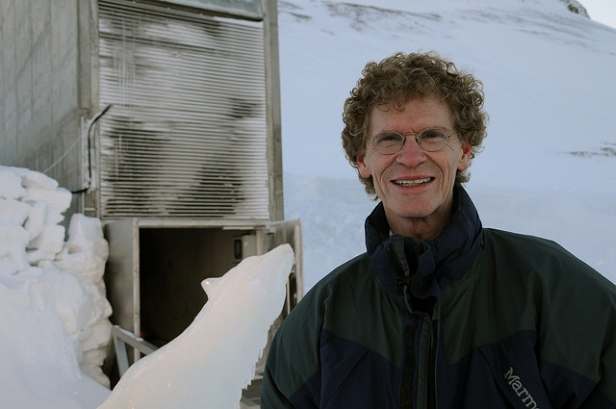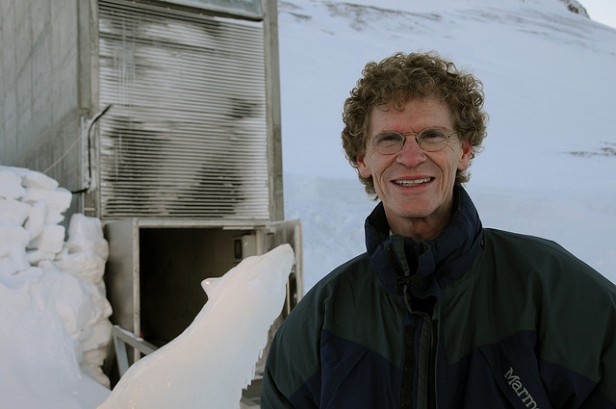 Global Crop Diversity Trust Executive Director Cary Fowler poses with the Svalbard “Doomsday” Seed Vault. Also, is that an ice sculpture of a polar bear?Photo: Mari Tefre/Global Crop Diversity Trust
Global Crop Diversity Trust Executive Director Cary Fowler poses with the Svalbard “Doomsday” Seed Vault. Also, is that an ice sculpture of a polar bear?Photo: Mari Tefre/Global Crop Diversity Trust
“People think I must be ‘Dr. Doom,'” Cary Fowler told the audience for the University of Washington’s sixth lecture on food and the environment.
Tall and soft-spoken, Fowler makes an unlikely Dr. Doom. As executive director of the Global Crop Diversity Trust, he’s devoted to the preservation of genetic variety in the world’s food crops, and has an obvious passion for the incredible variety of life.
His melodramatic nickname comes from his involvement in establishing the Svalbard Global Seed Bank, or the “Doomsday Seed Vault,” a sort of international insurance policy for agricultural crops against the dangers of an uncertain future. Like an external hard drive, it stores “backup” copies of seeds for one-third of all crop varieties (600,000 unique ones and growing).
Helping seed the future without a crystal ball
Very few of those seeds are regularly cultivated today. “For all of our technological wizardry, we still rely on a handful of crop varieties, rainfall, and a few inches of top soil,” said Fowler.
“We’re the first generation that can take food for granted,” said Fowler. “But we should be asking, Where did all of this previous abundance come from? Are the conditions still in place to feed a growing world population?”
The food we produce requires certain conditions of water, energy, land, nutrients, and climate, but those elements are no longer secure, he warned. Seed banks are invaluable resources for plant breeders/farmers who’re trying to raise varieties of crops that, for example, resist certain pests or are well-adapted to a particular microclimate’s moisture levels.
He asked the audience to consider the uplifting projections for climate change in places like South Africa. There, the hottest growing seasons of the past are expected to be colder than even the coolest growing seasons in the not-so-distant future. That’s bad news for food crops that have never faced these conditions, such as one rice variety whose yield drops 10 percent if the temperature rises just one degree Celsius during its nightly flowering period.
This is where the blessings of biodiversity really shine: Other rice varieties flower at different times of day, offering an opportunity to breed rice that can adapt to a changed climate and still feed the many hungry bellies. But only if those genetic varieties aren’t lost to carelessness, floods, power-failures, or war, which has been the fate of some crops at many seed banks around the world.
It’s at the end of the world as we know it
 Entrance to the Svalbard “Doomsday” Seed Vault, found in the seediest part of NorwayUncertainties like these are precisely the reason Fowler worked to set up the “Doomsday Seed Vault” somewhere far removed from civil war, conflict, and typhoons. Somewhere above the Arctic circle. That’s how Svalbard, Norway, an island town of 1,500 inhabitants, a few polar bears, and a lot of ice came to host the “biggest collection of biodiversity in the world,” according to Fowler.
Entrance to the Svalbard “Doomsday” Seed Vault, found in the seediest part of NorwayUncertainties like these are precisely the reason Fowler worked to set up the “Doomsday Seed Vault” somewhere far removed from civil war, conflict, and typhoons. Somewhere above the Arctic circle. That’s how Svalbard, Norway, an island town of 1,500 inhabitants, a few polar bears, and a lot of ice came to host the “biggest collection of biodiversity in the world,” according to Fowler.
“I cannot think of a more efficient way of dealing with water, energy, and climate issues than with crop diversity,” Fowler said. Not only efficient, but also cheap: Svalbard Seed Bank operates on a mere $200,000 a year. Dug deep into a frozen mountain, this seed bank is a giant, self-sustaining freezer full of seeds from countries all over the world. At -40 degree Celsius (and Fahrenheit), the seeds inside the vault would last 50 years even in the case of complete mechanical failure. Or Doomsday, if you prefer.
“Plenty of civilizations in the past thought they could dodge the bullet [of food insecurity],” Fowler warned. “We go to those archeological sites now.”
Statements like that are how Fowler got his Dr. Doom moniker. And yet he sees the seed vault as a positive project, a long-term, multinational collaboration involving every country in the world. “You don’t have to know all the answers to engage,” he said. “You don’t have to bear all the weight.”
Maybe all you have to do is have an appreciation for the beauty of 200,000 types of wondrous wheat, and start hanging on to a few seeds.



